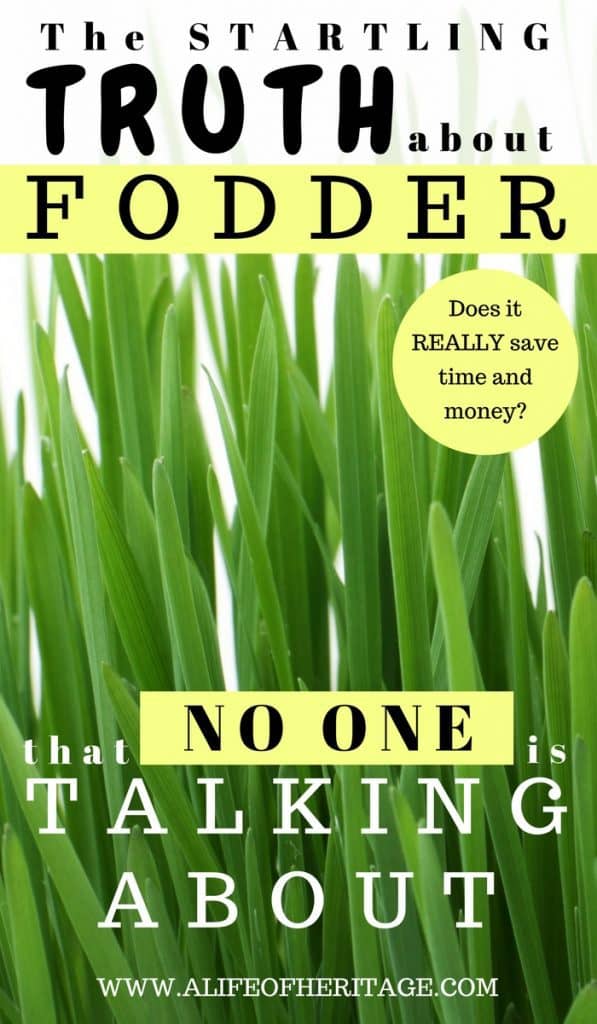
I was going to grow fodder for my animals. (Do you hear the stubbornness behind that statement?)
I had read all the articles and I was ready.
I had even made my fodder shelving and bought these awesome durable, heavy seedling trays. I was ready.
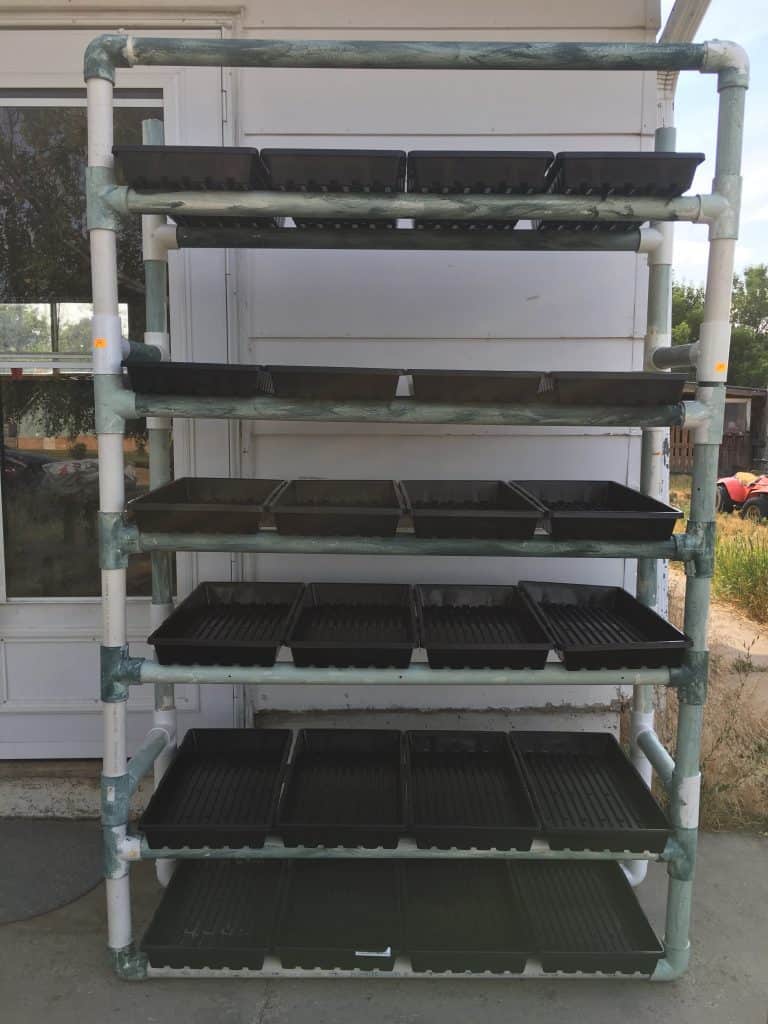
This was my setup ↑
Fodder Insights and Information
And then I decided to do a bit more research. I’m really good at jumping in and just doing something and then later wondering what in the world I was thinking. Are you like me in that regard? I hope not!
If you prefer to watch a video about this information instead of reading, click the video below!
If you like this information, my YouTube channel is full of even more goat information. Please click this link: Delci | A Life of Heritage and subscribe! You can also click this link to watch this information on YouTube: Fodder: the Startling Truth Video on YouTube
But I knew that there were three very specific things that had to happen if I was going to grow fodder for my animals:
- It had to lower the feed bill considerably
- Not add a crazy amount of time and work into my day
- And of course, I want my animals to have a boost in their health
In other words? It had to be worth it.
Worth the time investment and not be a detriment to our pocketbook. If you are already raising livestock, you already know this: animals are not cheap. And at every turn, we are looking for ways to raise healthy animals and save some money.
Who did I turn to for my information? I knew that I had to go deeper than the average blog post. I wanted to know really what was going on with feeding fodder and one of my first goals was to be able to create a calculator for myself (and you) to be able to use to calculate how much grain in pounds it would take to grow enough fodder in weight for the specific amount of animals that were owned.
Seemed easy enough.
So I reached out to Montana State University and found a very helpful and informative professor under the title: Extension Forage Specialist, Department of Animal and Range Sciences.
And I asked a lot of questions.
Definition of Fodder
But first, let’s begin with what these words even mean.
The definition of fodder according to Merriam Webster is this: “something fed to domestic animals, especially: coarse food for cattle, horses, goats or sheep.”
Very specifically speaking, “fodder” is the food that is fed to an animal by its owner, as opposed to “forage”. Forage is the food that an animal will find for itself in a designated pasture or area of grazing.
More recently there has been a resurgence of interest in sprouted grains, also now known as fodder. Usually, the grains are sprouted to about 6 inches tall, which will take approximately 6-10 days.
The week-old sprouts are fed to the animal in their entirety. Meaning, the leaves (grass), roots, and any remaining seeds that didn’t sprout are all fed to the animal and eaten. No dirt is involved. In this quick turnover of seed to grass, there is no need for dirt and the roots become a heavy mass that is rolled up and toted out to the animals.
How to Grow Fodder
Generally speaking, it is fairly easy to grow fodder. One article says that it is “practically effortless” to grow sprouted grains.
As a quick overview, here are the steps that people take to grow fodder to 6 inches:
- Clean the seed, if it wasn’t pre-cleaned before purchase
- Soak the seed for at least 12 hours and up to 24 hours
- Lay the seed out in trays no deeper than 1/2 an inch (these trays are so durable and strong! I couldn’t be happier with this purchase!)
- The seeds should be wet down with water 2-3 times a day and drained well each time. No standing water should be left in the trays.
- Do step number 4 until the growth has reached 6 inches. This will usually take between 6-10 days depending on the heat in the room and the amounts of water used for each watering.
- Harvest! Dump out the fodder (it’s heavy!) and either roll up or cut it up into manageable pieces.
- Feed to livestock.
- Clean and disinfect trays immediately and very, very well after each use.
- Repeat each day. Every day a tray is taken out, one replaces it making this a continual cycle of growing and harvesting.
Fodder systems can be as easy as setting a small container on the windowsill and they can also be set up to be completely automated after the seeds are in the trays. Some systems can be connected to a water source where the water is reused and pumped to rinse the seeds throughout the day automatically, which helps lessen the time spent manually rinsing several times a day.
Benefits of Sprouted Fodder?
Any article about sprouted fodder will give a very impressive list of benefits. And who wouldn’t want these benefits for their animals?
This list is found on many websites touting the benefits of growing sprouted seeds:
- Water use reduction and conservation compared to field irrigation
- Reduction in overall daily feed costs.
- Significant reduction of feed waste – the entire root mass is consumed with the grass
- Increased nutritional value in the feed
- High yield in a very small area
- Increase your independence by growing food for your animals with no need for cultivated land
- High digestibility
- Vitamins & mineral saturation
- Phytate reduction for pH normalization
- Enzymatic activity increase
- Increases in Omega 3, amino acids, natural hormones
- Hedge the increase in feed costs by pre-buying large quantities of grain to have on hand
- On-demand availability of fresh green feed 365 days a year – all-season access.
But this impressive list isn’t the beginning or end of this discussion. There’s more. A lot more.
Let’s explore if the grass is really greener on the other side…
The True cost of Sprouted Grains
In my research, I found that when talking to people who know what they are talking about in regards to animal nutrition, a lot of the wording and technical aspects of the conversation can quickly go over my head.
This subject about nutrition and the bioavailability of starches, sugars, and the makeup of grains, and hay can get deep and complicated very quickly. Not only can grains and grasses grown in different pastures and parts of the country have completely different nutritional content, but when, where, and how they were harvested also affects the outcome of the feed as well. And all grains are not equal either. Depending on dirt health, harvesting, age, and how long they were sprouted all change the outcome of what ends up being fed to an animal.
So in short, to say that my hay quality and nutritional makeup are exactly equal to your hay is impossible. This would also mean that my barley grain and the sprouts I produce, could not be said to be equal (or better or worse) without testing the specific grains used and the final fodder product.
Is this getting heavy? I hope not!
Because this is where the whole fodder conversation gets blown out of the water.
The Truth About Fodder
Well known or not, animal rations must be calculated and fed on a DRY MATTER basis only. This is so important, I must say it again: Animals MUST BE fed on a DRY MATTER basis only.
If you’ve done any research on fodder, one key phrase may have caught your attention: “1 pound of grain turns into 6 pounds of fodder!”
And what did you think? Like me possibly? “Wow! That’s amazing! How else can you multiply feed like that??”
But it’s a very deceiving claim.
Why? Because of the dry matter.
If you have lugged around a mat of fodder, you know how heavy it is! Incredibly heavy! And all that weight is moisture.
In fact, fodder is made up of about 80%+ moisture content compared to the 15% moisture found in hay.
This is the reality of fodder:
2 pounds of grain (1.9 lbs dry matter), which has approximately 95% dry matter (DM), grows into “grass” in 6-10 days, which weighs at this point 12 pounds and has 10% dry matter (DM).
2 pounds of grain=95% dry matter
2 lbs of grain → 12 lbs of fodder
12 pounds of fodder=10% dry matter
So what has the dry weight of the fodder become at this point?
In terms of dry matter the equation will look like this:
1.9 lbs of dry matter grain = .9-1.2 lbs of dry matter fodder
Wait, what?? The fodder has actually LOST dry matter. For every 2 pounds of starting seed, it will, in fact, have lost almost a pound of dry matter!
And why does this matter again? Because animals are fed on a dry-weight basis.
And when you are crunching numbers as I do continually, losing feed is not an option and if it happens, it is very costly and can be detrimental to the bottom line.
But how does this happen? What is going on inside the seed to lose dry matter?
The Reason Behind the Loss of Dry Matter in Fodder
When a seed is growing into a plant, it uses up its stored carbohydrates. This stored starch is used up during the first week of life. Usually, at this point photosynthesis takes over, roots develop and the plant can begin to uptake minerals. But in the case of hydroponic systems, dry matter and carbon are being used up during the 10-14 days of growth, which leads to the loss of dry matter.
So, the longer the sprouts are growing to reach the desired “6 inches of growth”, the more dry matter they are losing.
What About the Previously Mentioned Nutritional Quality Improvements?
Sadly (because I really like the idea of growing fodder) there isn’t any valid research backing up the nutritional quality improvements.
Now do animals usually love the fodder? Oh yes, they do! Chickens might knock you down to get to their fodder treats! The fresh, moisture-filled product is very palatable and pleasing to most animals.
But the reality is that the research done on the nutrition of fodder shows that not only is there a loss of dry matter but the “true protein decreased, and the non-fiber carbohydrate, metabolic energy, and in-vitro gas production decreased in sprouted barley compared with the raw seed.” ~Source
What does this mean for the fodder product? It has lost energy and has actually lost feed value when it is compared to the original seeds themselves. Those barley seeds? Their feed value is at least as good, if not superior, to the fodder.
If you do decide to grow fodder, studies have shown that growing fodder to day four will have the least amount of dry matter loss and will have the best digestibility. Growing past day four will show a significant loss in dry matter, energy, and digestibility. ~Source
Another factor that I hadn’t considered was this: “Thomas and Reddy (1962, Michigan State University) compared 8-day sprouted oats against whole or crimped oat grain when fed to dairy heifers. Digestibility of dry matter, protein, and energy were significantly higher on the processed grain diet than on the sprouted oat diet. Daily urine production increased from 4 liters on the control diet to 13 liters per day on the sprouted oats diet. Bedding needs would increase significantly to keep cattle clean and dry on the sprouted oat diet.” ~Source (Mentioned way down in the comments)
When Does It Make Sense to Sprout Grains?
Does this mean that it never makes sense to grow fodder? No, not necessarily.
Here are a few times when it makes sense to grow fodder:
- Low to no sources of quality hay
- A desire to be more self-sufficient while not owning land to hay
- Small animal treats. Chickens and rabbits will love the treat!
- Wanting to provide a varied diet
If you fall into one of those categories, great! But don’t forget to count the cost first. This will not be something that will save time, money, or feed.
What Are Some Cons and Challenges of Growing Fodder?
This was another important factor that I had to consider, despite my adamant desire to grow fodder for my animals. I wasn’t going to just grow a batch here and there of fodder. My original plan was to use fodder to supplement much of the hay we had to harvest and stack each year for my animals.
But I had to ask the hard questions. How much time would I have to devote a day to growing fodder? What are some of the challenges that come up and cause problems?
Are you like me? Lots of animals, young kids, a busy life…
I am looking for ways to simplify and improve. So what challenges come up for those growing fodder?
- The nutrient quality is solely and only dependent on the quality of the seed bought because only water causes it to grow. Low nutrient grain? Low nutrient fodder.
- Mold. That rich, brown dirt out your window? It has wonderful microbes that keep pathogens at bay. In a hydroponic system, mold, mildew, and other pathogens can quickly spiral out of control if the proper temperatures and humidity levels get out of control. And a moldy batch of fodder cannot be fed to animals, which is another potential loss.
- A controlled climate is needed to keep temperatures and humidity at appropriate levels.
- Time spent cleaning the seed (if it wasn’t pre-cleaned), soaking the seed, laying out the seed, watering (if an automatic system isn’t set up), cleaning the trays (to prevent mold), and feeding the fodder, can add a significant amount of time to chores.
- It’s an everyday, not miss-a-day type of system. No time off for you or the fodder.
- It is very wet and heavy and can become a challenge to transport.
- Depending on who you talk to, some found that their animals decreased milk production. ~Source
- Bulk feed storage can sometimes be a limiting and challenging factor.
- Electricity and a water source are needed and depending on the setup location, that can cause challenges.
But where there is a will, there is a way. Sometimes challenges can be mastered and if your heart won’t be content until fodder is made available for your animals, don’t let these reasons stop you!
The conclusion of Growing Fodder for Livestock
There is absolutely nothing wrong with growing fodder for your animals. Many people have jumped on the idea of growing sprouted grains. It feels like something you “should” do, right?
But if you are looking for ways to save time, money, and feed, this probably isn’t the solution you are looking for. No matter which way the equation is looked at, sprouted feeds are:
- More time consuming
- Less dry weight
- Less nutrient-dense than hailed
- Taking up space in the house, greenhouse, or garage
- Probably not going to save any money or feed
But I gotta tell you, I want fodder to be all that and a slice of bread, I really do. But the facts cannot be overlooked just because the internet says so in a handful of places or because I want them to.
Fodder has made a resurgence but it’s worth looking into the facts a little more deeply, isn’t it?
The grass just may not be greener on the other side after all.
If you would like further reading, this is an awesome source and the one article that got me to really start thinking about the reality of fodder: Hydroponic Forage
This article was written in 2013 and talks about the experience of several people using fodder. It would be interesting to hear the update, the verdict was still out on their profitability and its effectiveness: A Revolution in Animal Feed?
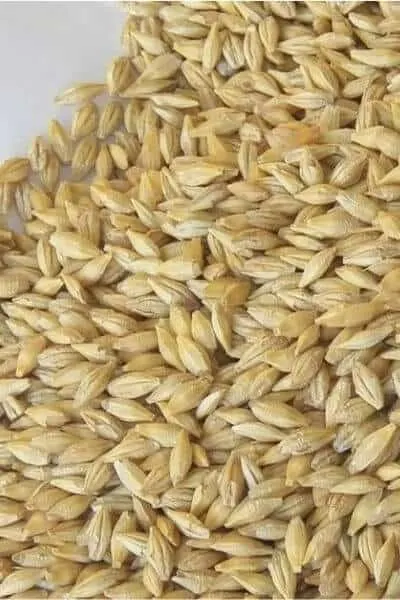
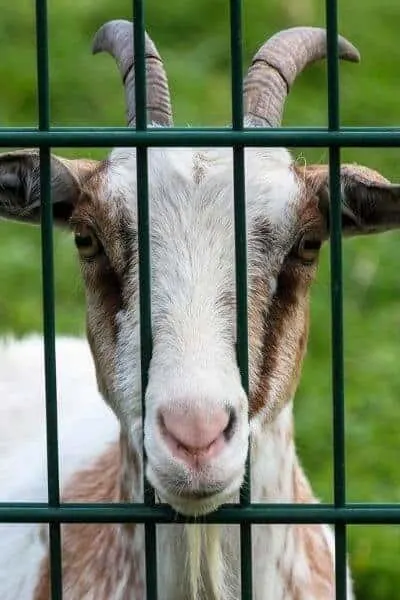
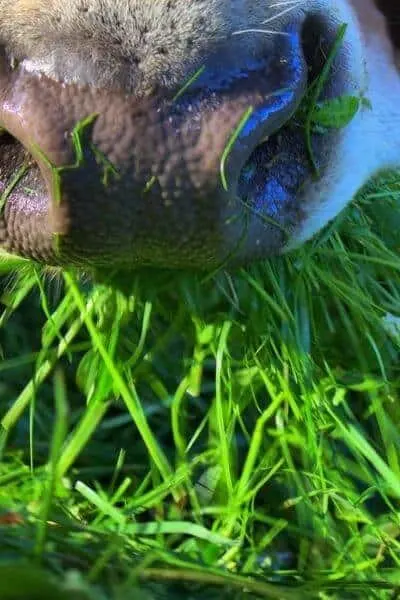
jesse
Friday 13th of October 2023
Thank you for writing this article! I found it very helpful because to test whether or not a food is good we need to see it's effect on the body, and I did not know about dry weight except in the context of freeze drying foods - and then after reading the comments, and having read some of thr articles in favour of fodder, I think i can safely say that my animals and my monthly balance sheets will need to tell me whether or not the fodder is worthwhile. So, now I have a whole list of changes to measure and to test for going forward: food usage dry weight, animal health, quality of eggs/meat/wool etc. I also have to watch for environmental changes that affect my results. I also noticed that in people, we eat a lot of carbohydrates to get few nutrients like in junk food and grains, whereas some people thrive on a carnivore diet or keto diet eating much less for the same or better results.
Delci Plouffe
Wednesday 29th of November 2023
I'm so glad it made you think! It's a big deal to just jump into without all the info! But when you figure it out, it may work out for you!
Katie Kesler
Sunday 14th of May 2023
Hello, I have started growing fodder for my small chicken flock and goose. They love their fresh green, but I have a horrible outbreak of gnats. they are breeding in the fodder too. Any suggestions? Thank you, Katie
Delci Plouffe
Wednesday 29th of November 2023
That is one problem that people say can happen. Keeping things very clean, possibly adding apple cider vinegar. Adding some gnat traps around. I hope you can figure out a solution.
Elizabeth
Wednesday 10th of May 2023
I’ve been sprouting lentils for my chickens (4-6 days depending on the season) for over a year. They love them! We do this as a supplement to their layer feed. I use mason jars on the window sill. Everyone raves about our eggs. Thank you for your article!
Delci Plouffe
Wednesday 29th of November 2023
so good to know! Great way to add to their diet!
Michael Wade Hewitt
Thursday 1st of September 2022
Dear Delci, I like your article and addresses the biggest question I had, is it worth it? On the other hand, IF the growing system has the minerals the plant needs to actually grow, not just the initial spirt from the seed, then maybe... I've built a 'Q-phonics' system that uses duck pond water and you have spurred me on to more research. My initial goal was cleaning the water and growing fodder as a by-product. appreciate any intel you might think would be helpful!
Michael
P.S.I do have irises that are 3' tall!! They can take the duck poo!
Delci Plouffe
Tuesday 27th of September 2022
This is really cool to hear! Thanks for sharing!
Dustin
Wednesday 9th of February 2022
The biggest issue here is all your comparisons we're between fodder and the grain itself. That's not the idea or design behind it. Go compare fodder to what you get out of your baled up fescue. Heck go compare it to your green fields of fescue or other average grasses your animals naturally have access to. And while yes, feed is based off of a dry matter, you must take into account the total amount of feed stuffs an animal can eat. Were your fodder to seed costs just based off the initial seed to fodder production? If so, go out and see how many pounds of barley seed you gotta throw out there to fill your cow for a day, beef cows average 40pounds of dry matter intake per day. While I do get the point of the argument you're making, you're comparing apples and carrots. Fodder is a replacement or supplement to lack of grass/grazing availability and or a replacement for lack of hay/or to avoid the cost of purchasing. Last year guys were paying $80-90 for a round bale of stickers and shrubs, bet they would've gladly spent a few dollars on high moisture fodder instead.